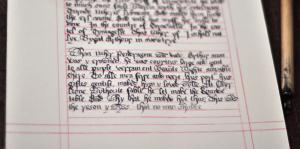Posted on December 4, 2009
Iron Gall Ink
In an effort to get closer to the medieval techniques that I emulate in my calligraphy, I have started using Iron Gall ink. This was the ink most commonly used in the Middle Ages (and beyond). It’s interesting stuff: you start with oak galls, which are round growths found on oak trees. Oak galls appear when a wasp lays its eggs on an oak tree: the tree responds by building a ball around the eggs, and that ball is full of tannic acid, the same stuff that is used to tan leather. The oak gall is crushed up and mixed with liquid, and then iron salt is added to it. This makes a very dark black (or sometimes purplish) ink that is waterproof and does not fade, and which absorbs very well into parchment.
You can still buy iron gall ink today. It is very interesting stuff to work with. It is a very thin liquid (at least the stuff I am using is). When you first write with it, it is a very pale grey, almost clear. This makes it a challenge to use until you get used to it: when I write with it, I find myself pressing very hard with the nib because I feel like I’m not actually making much contact with the paper, or dipping my nib in the ink more frequently then I need to. But within an instant of contact with the air, the ink begins to darken. You can watch it get darker and darker over the first few seconds that it is on the page. It gets quite dark quite quickly, but if you come back in 24 hours and look at it again, you will see that it has gotten even darker. It darkens to a satisfying deep black color.
In the picture below, you can see the text darkening as it ages:
Iron gall ink is definitely a challenge to work with at first, but the results are well worth it, especially on parchment!

